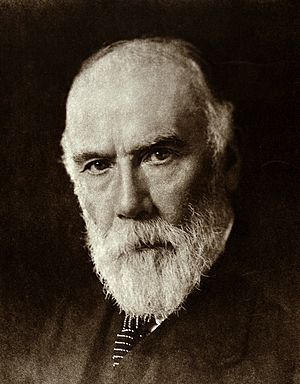James Mackenzie (cardiologist) facts for kids
Quick facts for kids
Sir James Mackenzie
|
|
|---|---|
 |
|
| Born | 12 April 1853 Scone, Scotland
|
| Died | 26 January 1925 (aged 71) London, England
|
| Nationality | Scottish |
| Scientific career | |
| Fields | Cardiology, General Practice |
Sir James Mackenzie (12 April 1853 – 26 January 1925) was a Scottish doctor who became a very important heart specialist. He was one of the first people to really understand how the heart's rhythm works. Because of his amazing work with hearts, he is known as a giant in medical research. King George V even made him a knight in 1915!
Contents
Who Was Sir James Mackenzie?
James Mackenzie was born in a place called Pictonhill in Scone, Scotland. His father was a farmer. When James was 14, he left school and started working for a chemist. In 1873, he was offered a chance to become a partner in the chemist's business. But he decided to study medicine instead.
He studied Latin privately and passed his entrance exam for the University of Edinburgh in 1874. He became a doctor in 1878. After finishing his training in Edinburgh, Mackenzie became a general practitioner. This means he was a family doctor who saw all kinds of patients. He worked in borough of Burnley in Lancashire, England, for more than 25 years.
Mackenzie's Early Discoveries
Even though he was a busy family doctor, Mackenzie made many new observations. He earned his MD degree in 1882. He also had many scientific papers published. During his early research, he talked about his findings with other famous doctors. These discussions helped him learn even more.
Mackenzie's studies led him to become a heart specialist. He worried that doctors might focus too much on one small part of the body. He believed doctors should look at the whole person. He said, "I fear the day may come when a heart specialist will no longer be a physician looking at the body as a whole."
Understanding the Heart's Rhythm
In his early studies, Mackenzie used a tool called a sphygmograph. This tool helped him record the pulse from a patient's wrist. Later, he invented his own tool called a "polygraph." This polygraph could record two pulses at the same time. It helped him check the heart's condition.
In 1890, he discovered something called premature ventricular contractions. These are extra heartbeats. Using his polygraph, Mackenzie learned to tell the difference between harmless and dangerous heart rhythm problems. These problems are called cardiac arrhythmias. He also showed that a medicine called Digitalis could help treat these arrhythmias. He made important discoveries about how the heart muscle works.
Later Life and Legacy
In 1907, Mackenzie moved from Burnley to London. He became a consulting physician, and his reputation grew very quickly. In 1915, he was made a Fellow of the Royal Society. This is a very high honor for scientists. He was also knighted, which means he was given the title "Sir."
Three years later, he started the Mackenzie Institute of Clinical Research. This institute was in St Andrews, Scotland. It helped local family doctors record details about their patients' symptoms and illnesses over a long time. This helped doctors learn more about how diseases develop.
Mackenzie's Own Heart
It's interesting that Mackenzie himself had an irregular heartbeat. He suffered from a heart condition called ischemic heart disease. He had his first heart attack in 1901. He even recorded his own heart rhythm problems during this time.
By 1907, he often felt chest pain, which is called angina pectoris. In 1908, he had a very bad episode of heart pain. This was probably another heart attack. His angina got worse over time. In January 1925, he had a long and severe attack of angina. He passed away on January 26, 1925.
Before he died, Mackenzie asked his friend, John Parkinson, to perform an autopsy. An autopsy is when doctors examine a body after death to learn more about the illness. The autopsy showed that Mackenzie had serious problems with his heart's blood vessels. It also showed signs of old and new heart attacks.
Today, you can see some of Mackenzie's early polygraphs and a bronze statue of him. They are kept at the Tayside Medical History Museum.
Images for kids



